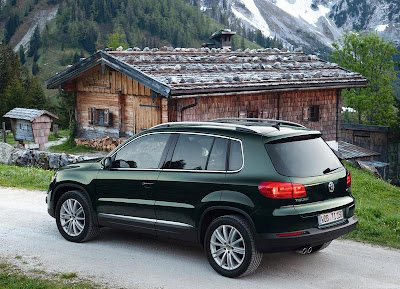The new VW Tiguan is here. An SUV with design parallels to the larger Touareg. An SUV with powerful and at the same time fuel-efficient engines; fuel consumption is 5.3 litres per 100 km for the two front-wheel drive Volkswagen Tiguans 2.0 TDI with BlueMotion Technology (81 kW / 110 PS and 103 kW / 140 PS). An SUV that shuts off the engine completely whenever possible in city driving thanks to a Stop/Start system. An SUV that is an ideal, versatile companion for life on the move with its excellent all-round characteristics, great practicality, 1,510 litres cargo space, up to 2,500 kg trailer load (with 4MOTION all-wheel drive) and many cleverly designed features. A Volkswagen in the best sense of the word! In Germany, the perfected Tiguan will arrive on the market in mid-June 2011; other European countries will follow at the beginning of August, and overseas markets at the end of August.
In Volkswagen's line-up of four-cylinder engines, DSG has replaced the conventional torque-converter automatic transmissions. In the new Tiguan, an extremely fast and efficiently working 7-speed DSG version is used. Its most prominent design characteristics - two dry clutches whose pressure is regulated hydraulically. Engine power is transmitted to the dual clutch via the crankshaft and a dual-mass flywheel. Clutch I handles the odd-numbered gears, and clutch II the even gears plus reverse gear. The results of this sophisticated clutch management: when shifting, there are no gaps in propulsive power. Comfort and convenience are excellent, and the driver experiences an incomparably dynamic yet comfortable shifting feeling.
Read more In Cars
In Volkswagen's line-up of four-cylinder engines, DSG has replaced the conventional torque-converter automatic transmissions. In the new Tiguan, an extremely fast and efficiently working 7-speed DSG version is used. Its most prominent design characteristics - two dry clutches whose pressure is regulated hydraulically. Engine power is transmitted to the dual clutch via the crankshaft and a dual-mass flywheel. Clutch I handles the odd-numbered gears, and clutch II the even gears plus reverse gear. The results of this sophisticated clutch management: when shifting, there are no gaps in propulsive power. Comfort and convenience are excellent, and the driver experiences an incomparably dynamic yet comfortable shifting feeling.
PHOTO GALLERY
Advertisements
Read more In Cars



















0 comments:
Post a Comment